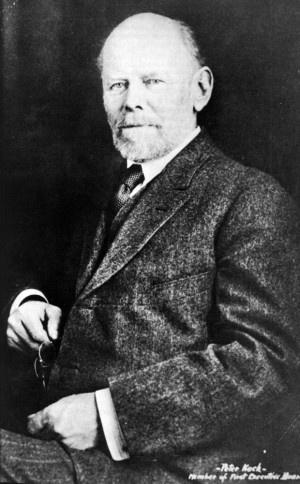Peter Koch Walked the Gallatin Valley
In a historical sketch written in the 1890s, Danish immigrant Peter Koch described what he had observed earlier during his tramps about the Gallatin Valley in the 1870s. However, he said, most of the physical evidence of first visitors had disappeared with recurring heavy snows, spring runoff, and disturbance of the land from settlement. Koch had studied at the University of Copenhagen, but left at the age of twenty-one to explore the West, most particularly Montana. His career included a stint as a sutler at Fort Ellis in 1869, a bookkeeper in Bozeman, a bank cashier, surveyor, and county attorney. He helped start the city’s library and was the driving, if not stubborn, force in developing a college for Bozeman.
On one of his walking tours, Koch looked over what was left of fur trader Manuel Lisa’s stockade, built on the banks of the Madison River in 1810 near the three forks of the Missouri. Koch studied the entrenchments and what little was left of the camp debris abruptly abandoned by Lisa’s men. At first, the location seemed ideal, with a number of Indian trails leading to and from the site – a favorable situation for trade. Captain William Clark had taken note of these trails in his journals and Koch followed each of them on his jaunts. One led to the south of the Gallatin Valley, and swung east through the wooded foothills to Bozeman Pass. Another crossed the valley floor on a direct route to the pass. One trail led to the mouth of Gallatin Canyon. Still another crossed west along the ridges of what later became the Flying D Ranges to the Madison River. Earlier hunters followed these trails, Koch reasoned, hoping to find bison grazing near the Yellowstone River.
Manuel Lisa, however, had not reckoned with the dominance of the Blackfeet warriors who had moved down from the north. The Blackfeet successfully fought the Crow, the Flathead, the Shoshone, and other tribes who, after engaging the Blackfeet in battle, scattered to safety, away from the Gallatin Valley. The Blackfeet "came too often for the success of Manuel Lisa," wrote Koch. Lisa’s men abandoned the fort that same season and hurried south to Henry’s Lake, Idaho. Some independent fur trappers feckless enough to venture into the region learned the hard way about the fierce ways of the Blackfeet. Alas, wrote Koch, "they were men of the rifle and the knife, not of the pen. . . . How we should treasure it now, if we knew the wonderful adventures which must have happened to those rovers along the banks of our familiar streams. Doubtless the waters of all of them had been reddened many a time by their blood."
Koch also wandered through the site known as Gallatin City near the Three Forks, once predicted to become a thriving metropolis of the West. The settlement, he wrote, "was laid out by certain enterprising Missourians who expected it to prove the head of navigation on the Missouri, forgetting that there was slight obstruction below in the shape of tremendous falls. After receiving a few lessons in geography most of them abandoned the location."
Peter Koch poked about a "kitchen midden" near Middle Creek where he found piles of buffalo bones several feet deep, along with arrowheads and tools. Hiking along Sourdough Creek, he took note, "many a band has probably camped on this very creek and concealed themselves from the lurking Blackfeet in the thicket, which a few years ago covered the ground, on which some of the stateliest buildings of Bozeman now stands." Early settlers, he wrote, built the first home on the site of the Bozeman Hotel.
Koch tramped through Bozeman Pass in all seasons. "I know Bozeman Pass well. I have toiled over it through the deep snows of winter and the bottomless mire of spring. I have crossed it when, dressed in all colors of the rainbow by its matchless flowers, or when ablaze with the russet and gold of its autumn woods." On his hikes in the area, he would think of Captain Clark and his men, climbing the "big hill" to view the Yellowstone for the first time. He also thought of a naked John Colter, cold and hungry, on the run from the Blackfeet, on his way to safety at the fort on the Yellowstone.
Peter Koch’s prose is perhaps florid but it also reflects a forceful personality that always displayed an endless curiosity about the physical nature of the Gallatin Valley.






